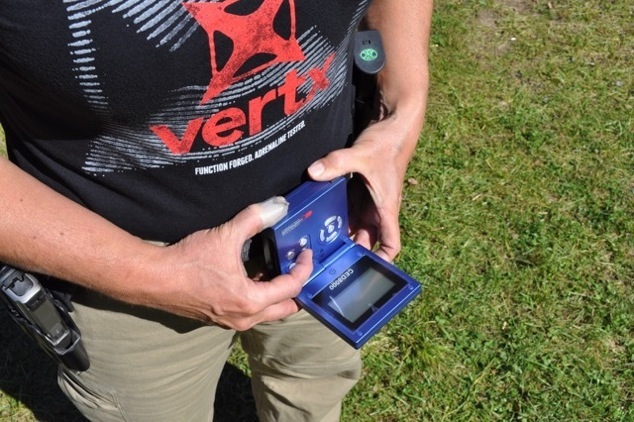During the competition season, when I have the opportunity to practice, I always bring along my shot timer. Many shooters hear that high-pitched beep only during a match, because it is most likely one of the least-used tools for training. If you’re like me, you might have never even touched a timer before, but I want to convince you why you should use a shot timer as a training tool.
I hadn’t, until I bought my own, a Competitive Edge Dyamics CED8000RF timer.

The CED800 Timer has one of the largest viewing screens and many features. MSRP: $149.00 (Chris Cerino photo)
The basic function of a shot timer is to measure the exact time between the start signal and the final shot, with a whole lot of options in between. Although functions vary among different brands, most will display the following features:
How to Read a Shot Timer
When reading the shot timer as soon as I finish a drill, the number showing is the time the final shot was made. I can then press the review button, which shows me when each shot was fired and the amount of time between shots. For example, looking through the review I may see: 1.75, 2.10, 2.35. This means there were 3 shots fired. After the beep, my first shot was at 1.75 seconds, the second shot was a third of a second later, and the final shot was a quarter of a second after that. The time between each shot is the “split time.”
Using Your Shot Timer to Train
I can break down the training in many ways. Let’s begin by using the “Start Delay” feature. Since this allows me a few seconds before the start beep, I’m able to practice my draw from a relaxed position. When I review the times, I can see when my first shot went off. Now I have a number to work with. I am able to set a measurable goal of increasing the speed of my draw.
Also, using the review function, I can look at my split times. Am I able to shoot a cadence of fire? Is there a certain point where the time increases or decreases? Through training and practice, I work on decreasing the time between each shot. Again, I can measure my increase of speed by reviewing the decrease in split times, and am able to record the progress.
Everything until now would be live-fire practice, on the range. However, there are times I need to train and cannot get outside. That is when I practice my draw using the par time feature with dry fire. As always, when practicing dry fire, make sure your firearm is unloaded. I begin by setting the timer for 3 seconds. That allows me to practice smooth movements, making sure my form is solid. At the first beep, I draw my pistol, make the sight picture on my intended target and press the trigger. After a while I start decreasing my time, trying to increase my speed, so I am pressing the trigger before the second beep. Once I am confident of the time, I will then decrease another increment.
Whether live fire or dry fire, I can also use the par time feature for reloads. For dry fire, I start with 2 EMPTY magazines. One in my magazine pouch, and the other in my pistol, with the slide locked back. Upon the first beep, from the sighted-in position, I drop the empty magazine, retrieve the EMPTY mag from my mag pouch, and perform a reload. My goal is to be back on target, with the proper sight picture before the second beep. The live-fire equivalent would be to load 1 bullet into the chamber and have a magazine of 2. Either from the high ready or holster, I fire the first shot. Since the gun is now dry, I perform a reload and shoot the next 2 shots. Again, the goal being to have fired the third shot before the second beep.
When practicing with the timer, it is important to set goals. There are many variables involved in the timing of a shot. What size is the target? How close is it to the shooter? Are you using a security holster? Start out with times that you are comfortable with, and can perform flawlessly. Do not sacrifice form for speed. Find the point where you are making accurate hits, the fastest you can.
Bringing a notebook along when training is a great way to keep track of your progress. Note the speed at which you start each training session, and the speed you’re at when you end. Try to make an improvement, no matter how small, at each session.
This Retro WON first appeared December 16, 2014.
Michelle Cerino, aka Princess Gunslinger, first entered the firearms industry in 2011 as co-owner, president and trainer at a national training company. She immediately began competing in both 3-Gun and NRA Action Pistol, becoming a sponsored shooter. Michelle is currently a columnist and Managing Editor of Women’s Outdoor News, as well as owner of Pervenio LLC. She also manages social media for Vera Koo and FASTER Saves Lives. Michelle encourages others to step out of the comforts of home and explore. View all posts by Michelle Cerino